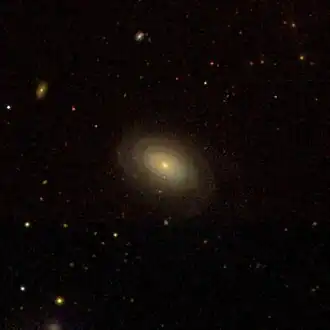NGC 223
| NGC 223 | |
|---|---|
 SDSS image of NGC 223 | |
| Observation data (J2000 epoch) | |
| Constellation | Cetus |
| Right ascension | 00h 42m 15.9s[1] |
| Declination | +00° 50′ 44″[1] |
| Redshift | 0.017772[1] |
| Distance | 238 Mly[2] |
| Apparent magnitude (V) | 14.0g[1] |
| Characteristics | |
| Type | SB0[1] |
| Apparent size (V) | 0.42' × 0.29'[1] |
| Other designations | |
| IC 44, UGC 00450, CGCG 383-074, MCG +00-02-129, 2MASX J00421585+0050432, IRAS F00397+0034, PGC 2527.[1] | |
NGC 223 is a spiral galaxy located approximately 238 million light-years from Earth.[2] It is located in the constellation Cetus. It was discovered on January 5, 1853, by George Bond.[3]
See also
References
- ^ a b c d e f g "NASA/IPAC Extragalactic Database". Results for NGC 0223. Retrieved 2016-09-02.
- ^ a b An object's distance from Earth can be determined using Hubble's law: v=Ho is Hubble's constant (70±5 (km/s)/Mpc). The relative uncertainty Δd/d divided by the distance is equal to the sum of the relative uncertainties of the velocity and v=Ho
- ^ "New General Catalog Objects: NGC 200 - 249". Cseligman. Retrieved September 10, 2016.
External links
 Media related to NGC 223 at Wikimedia Commons
Media related to NGC 223 at Wikimedia Commons- NGC 223 on WikiSky: DSS2, SDSS, GALEX, IRAS, Hydrogen α, X-Ray, Astrophoto, Sky Map, Articles and images
- SEDS